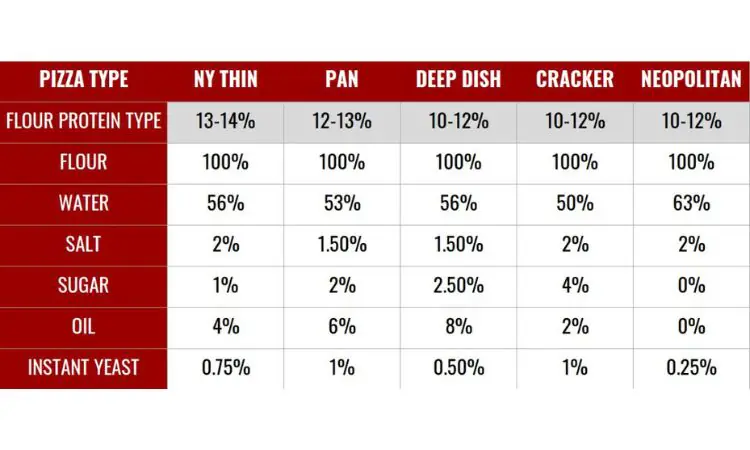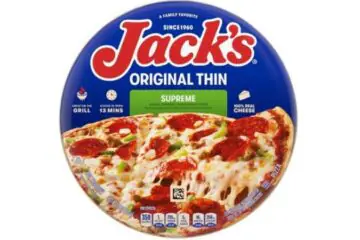How Much Sugar in Pizza? A typical slice contains approximately 3 to 5 grams of sugar, but this sugar content can vary depending on the ingredients and pizza sauce used.
Understanding the sugar content in our favorite foods is crucial for maintaining a balanced diet. While often categorized as savory, pizza contains sugar, primarily in the crust and tomato sauce. The amount of sugar can be influenced by factors such as the type of dough, the sweetness of the sauce, and any added ingredients like pineapple or barbecue sauce, which are higher in sugar.
While enjoying a slice occasionally is fine, being mindful of added sugars is essential for overall health. For those watching their sugar intake, opting for a pizza with a thin crust and fresh, less processed toppings can help manage the sugar content without sacrificing flavor. Remember, moderation is key to a healthy diet, which also applies to pizza consumption.
The Sweet Component In Savory Slices
The Sweet Component in Savory Slices often escapes notice. When people think of pizza, cheese, and pepperoni spring to mind, not sugar. Yet sugar plays a part in both the base and the topping. Let’s uncover its presence in your favorite slices and understand why.
Sugar’s Role In Pizza Dough
Though not apparent, sugar in pizza dough is crucial. It feeds the yeast, which helps the dough rise. A small amount of sugar yields a light, airy crust. Pizza dough with sugar might be more tender. At home or in restaurants, sugar is added to pizza dough for taste and texture.
Toppings And Sauces: Hidden Sugars
Sugar hides in pizza’s toppings and sauces. Many commercial pizza sauces contain sugar, which enhances flavor and balances acidity. Toppings can also add sugar. For instance, processed meats like bacon carry sugar. Vegetables naturally contain sugars, too. These hidden sugars can add up without notice.
| Ingredient | Average Sugar Content |
| Pizza Dough | 0-1g per slice |
| Tomato Sauce | 1-3g per tablespoon |
| Meat Toppings | 0.5-1g per topping |
| Vegetable Toppings | 0.2-0.5g per topping |
- Read labels carefully.
- Choose natural or homemade sauces.
- Opt for fresh toppings to minimize added sugars.
Sugar Content: A Slice-by-slice Analysis
Welcome to our detailed slice-by-slice analysis of sugar content in pizza. One might not associate pizza with sugar, but the truth is, it’s there, nestled among the layers of cheese and pepperoni. Understanding how much sugar is in each bite can be quite the revelation, guiding healthier choices for pizza lovers everywhere.
Comparing Sugar Levels In Different Pizza Types
Every pizza has a unique sugar footprint. It depends on the crust, sauce, and toppings. Let’s peel back the layers:
- Thin Crust: Less dough means less sugar.
- Classic Hand-Tossed: A moderate amount of sugar resides here.
- Deep Dish: More dough equates to more sugar.
Check this table to see the differences:
| Type of Pizza | Sugar Content |
| Thin Crust | 2g per slice |
| Hand-Tossed | 4g per slice |
| Deep Dish | 6g per slice |
Commercial Pizzas Vs. Homemade: Sugar Comparison
Commercial pizzas often come with added sugar. Homemade pizzas, on the other hand, can be crafted with less sugar. Here’s how they generally stack up:
- Commercial Pizza: They can contain hidden sugars in sauce and dough.
- Homemade Pizza: You control the sugar, from the crust to the toppings.
For a clearer picture, let’s compare two similar pizzas:
| Pizza Type | Commercial (per slice) | Homemade (per slice) |
| Margherita | 5g | 2g |
| Pepperoni | 6g | 3g |
The Health Implications Of Sugar In Pizza
Pizza is a beloved dish around the world. You might not think of sugar when you think of pizza, but sugar hides in many foods. This section looks at how sugar in pizza affects your health.
Understanding Glycemic Impact
The glycemic impact refers to how fast your body converts food into sugar. Fast conversion can spike your blood sugar levels. This is not good for your health. Pizza dough often contains sugar. This helps the yeast make the dough rise. However, it can also raise the glycemic impact of pizza.
Here are some factors that change this impact:
- Ingredients: What’s in the dough and sauce can make a difference.
- Toppings: Veggies are better than sweet sauces or processed meats.
- Crust thickness: A thinner crust usually means less sugar.
Long-term Effects Of Dietary Sugars
Eating sugary foods can lead to health issues over time. It’s not just sweets. Pizza can be a source of added sugars, too. Here’s how dietary sugars can affect you:
| Health Concern | Explanation |
| Weight Gain | Overeating sugar can cause you to put on weight. |
| Diabetes Type 2 | Consistent high blood sugar can lead to diabetes. |
| Heart Disease | Sugar can increase the risk of heart problems. |
To make better choices, check the nutritional info on your pizza. Choose options with less sugar. Remember, a healthy diet has balance and moderation.

Navigating Nutritional Labels
Navigating Nutritional Labels can seem like decoding a secret language, especially with foods like pizza, which may not scream ‘sugar’ at first glance. Yet, understanding the sugar content is crucial for a balanced diet. This section will guide you through the maze of sugar information on pizza packaging and clarify sugar labeling rules. Arm yourself with knowledge and make informed choices about your next slice.
Deciphering Sugar Information On Packaging
Determining the sugar content in pizza involves a close look at the nutritional label. Manufacturers list total sugars under the carbohydrate section. Total sugars combine natural and added sugars. Natural sugars come from ingredients like tomatoes for pizza, while added sugars may be in sauces or dough. Here’s how to interpret the numbers:
- Check ‘Total Carbohydrate’ to find ‘Total Sugars’ underneath.
- Understand that ‘Includes Added Sugars’ means to see sugar added during processing.
- Measure in grams (g) – compare to daily intake recommendations.
Regulations And Recommendations For Added Sugars
Regulations ensure transparency in sugar content labeling. The Food and Drug Administration (FDA) mandates that packaging shows added sugars in grams and % Daily Value (%DV). This helps gauge how much of the recommended daily intake a serving of pizza contains. Remember these points:
| Advisory Body | Max Added Sugars (per day) |
| FDA | 50g for 2,000 calories daily |
| World Health Organization (WHO) | 25g for additional health benefits |
Identify the %DV to see how one slice fits into your daily sugar allowance. Aim for a low %DV of added sugars to maintain a healthier diet. If you are comparing products, opt for the one with fewer grams of added sugars. Doing so helps you manage sugar intake without sacrificing the joy of eating pizza.
Mitigating Sweet Surprises In Pizza
Mitigating Sweet Surprises in Pizza: Finding out there’s sugar in pizza might shock many. Pizza, known for its savory flavors, sometimes hides sugar in its sauce or dough. Knowing where sugar lurks and how to choose options with less sugar is vital. Pizza lovers can enjoy their favorite slice with fewer sweet surprises.
Choosing Lower-sugar Pizza Options
Read the Labels: When shopping for pizza, start by reading the nutrition labels. Look for words like “sugar,” “high-fructose corn syrup,” or “dextrose.”
- Go for Thin Crust: Thick crusts often contain more sugar. Choose thin crusts for a lower-sugar option.
- Check the Sauce: Many brands add sugar to their sauce—Hunt for pizzas with “no added sugar” on the label.
- Top Wisely: Select fresh veggies or proteins like grilled chicken over sweetened toppings like barbeque chicken.
The Pros Of Preparing Pizza At Home
Control Ingredients: Making pizza at home means controlling what goes in. Swap out sugar-laden ingredients for healthier alternatives.
- Make Your Sauce: Homemade tomato sauce can be made with fresh tomatoes, herbs, and spices, devoid of added sugars.
- Choose Whole Ingredients: Select whole ingredients for toppings—fresh produce and unprocessed meats are best.
- Experiment with Dough: Try making dough with flour alternatives, such as almond or coconut flour, that don’t need extra sugar.
Love Every Bite: Enjoy creating your pizza masterpiece. Know that it’s as wholesome as it is delicious.

The Sugar Reduction Movement In Pizzerias
What’s the buzz about sugar in pizza? The truth may surprise you. Not all sweetness comes from sodas or desserts. Your favorite slice might hold hidden sugars, too. Pizzerias across the globe are now part of a movement. They aim to cut back on sugar without losing flavor. Let’s explore the tasty world of low-sugar pizzas.
Innovations In Low-sugar Dough Recipes
Pizza dough, the canvas for toppings, once hid sneaky sugars. Not anymore. Crafty chefs are rewriting the recipe book. They swap out sugar-rich ingredients for natural ones. These new recipes use honey or agave or even leave sugar out entirely. This switch gives health-conscious eaters a reason to rejoice.
- Yeast ferments sugar naturally, reducing the need for added sugars.
- Whole wheat and other flours offer flavor without extra sweetness.
Consumer Demand Driving Healthier Choices
Customers are speaking out. They want their meals to be delicious but also nutritious. Pizzerias listen and act. The demand for healthier pizza drives change. Menus now feature bold, new options with less sugar.
| Old School | New Wave |
| Traditional dough recipes | Low-sugar innovations |
| Added sugars in sauce | Natural, sugarless sauces |
Kids and adults can now enjoy a slice without worry. With each low-sugar bite, they join a movement for better health.
Beyond Pizza: Examining Sugar In Other Comfort Foods
Peeking into the sugar content of pizza can lead to surprising discoveries. The quest doesn’t end with a single food item. Other comfort foods also share the spotlight for their sugar content. Let’s dive deeper into this sweet affair. We’ll shine a light on the sugars hiding in many beloved dishes.
Comparative Sugar Content In Popular Foods
Everyone adores a good snack, but sugar often sneaks into the most beloved ones. The table below showcases the sugar levels in different comfort foods:
| Food Item | Sugar Content |
| Chocolate Chip Cookie | 4 g per cookie |
| Macaroni and Cheese (Prepared) | 6 g per serving |
| Canned Soup | 7-12 g per can |
| Ice Cream | 14-28 g per scoop |
The Hidden Sugars In ‘Healthy’ Alternatives
Even foods labeled ‘healthy’ can contain more sugar than expected. The list below uncovers some common culprits:
- Yogurt: Often labeled as a healthy breakfast or snack, some flavored yogurts can pack up to 19 g of sugar per cup.
- Granola Bars: Marketed as a nutritious on-the-go snack, a single bar can contain 8-12 g of sugar.
- Salad Dressings: Savory salads may not be safe from added sugars, with up to 5 g in 2 tablespoons of certain dressings.
- Instant Oatmeal is convenient and comforting, yet a flavored packet can surprise you with up to 15 g of sugar.

Making Informed Choices For A Balanced Diet
Navigating the maze of dietary choices can be challenging. The sugar content in unexpected places, like pizza, might surprise you.
While pizza may not be the first food to come to mind when considering high-sugar dishes, the sauces and toppings can add more sugar than expected. Making informed choices is crucial for a balanced diet. Understanding the sugar content in pizza helps maintain this balance while enjoying your favorite slice.
Integrating Pizza Mindfully Into Your Diet
Eating pizza doesn’t mean abandoning nutritional goals. Mindful integration implies enjoying pizza in a way that aligns with your dietary aspirations. Here are some strategies for incorporating pizza into your balanced diet:
- Portion Control: Opt for a slice or two and pair it with a salad.
- Homemade Options: Make pizza at home using whole grains and fresh ingredients.
- Healthy Toppings: Choose vegetables and lean protein toppings.
- Low-Sugar Sauce: Select or make sauces with less sugar.
The Importance Of Whole Food Selections
Prioritizing whole foods over processed options can significantly reduce unexpected sugar intake. Whole, unprocessed ingredients contribute to better health and nutrition. The switch to entire foods involves:
| Processed Food | Whole Food Alternative |
| White bread crust | Wholegrain crust |
| Sugary pizza sauce | Homemade tomato sauce |
| Processed meats | Grilled chicken or veggies |
| High-fat cheese | Reduced-fat or plant-based cheese |
Opting for whole-food selections reduces sugar intake and increases a meal’s nutritional value. Thus, pizza can remain part of a balanced and mindful diet.
Frequently Asked Questions Of How Much Sugar In Pizza
Is There A Lot Of Sugar In Pizza?
Pizza typically does not contain much sugar; it’s generally low in sugar. The primary components are dough, cheese, and tomato sauce, which include minimal sugar. However, certain toppings and sauces could add more sugar.
Can Diabetics Eat Pizza?
People with diabetes can eat pizza, but moderation is key. Choose a thin crust, low-fat cheese, and pile on vegetables for a healthier option. Monitor blood sugar levels to manage the impact.
Can You Eat Pizza On A No-Sugar Diet?
You can eat pizza on a no-sugar diet, but choose a pizza with a sugar-free crust and sauce. Opt for toppings rich in protein and vegetables instead of processed meats or sweetened toppings. Always check the ingredients for hidden sugars.
Does Pizza Have Refined Sugar?
Most pizza dough does not contain refined sugar, but some recipes or premade crusts may include it. Always check the ingredient list to be sure.
Conclusion
Understanding the sugar content in pizza is key to mindful eating. This savory favorite can hide unexpected sugar, often in the sauce. Choose wisely, opting for options with lower sugar levels. Staying informed helps manage intake, benefiting your health without sacrificing enjoyment.
Remember, knowledge is the ingredient for healthier choices.

As the author of the “Ultimate Pizza Guide: Recipes, Tips & Secrets Revealed,” I’m dedicated to sharing my love for pizza and empowering others to create delicious homemade pizzas with ease. Join me on a journey to uncover the secrets to perfecting your pizza game!


